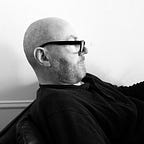Monuments, Pt. 1
It is thought cabbage was domesticated by the Celts somewhere in Europe around Knocknagoshel. I imagine it was running wild before that and if you were a hunter chasing it downhill you were at a disadvantage. On each summer solstice, tourists still race against heads of cabbage down these wild dock-leaved hills and always will. There is a monument here in the Village Square dedicated to the Cabbage Soldiers. A bronze casting of a young soldier holding the arm of a blind man. A beautiful, if sentimental homage to the children who were fostered into warrior training. Gathered at midnight in dark gardens of long-stemmed cabbages, swords unsheathed, each boy was required to decapitate as many cabbages as he could in forty-ish minutes. A blind man followed each young soldier counting the heads as he popped them into his back sack. Some people whisper that all the blind men were once soldiers training in the cabbage gardens.
I am sitting in Walsh’s bar in Knocknagoshel with Dr. Quil’s son talking about the Foundation. I like to come here when I visit Ted’s farm which is just beyond the village. It was in a field there in 1959, Dr. Quil, the infamous botanist, unearthed a remnant of an outer leaf of cabbage on top of which was a false tooth dating back to when our ancestors first crawled onto land.
It is now the National Cabbage Heritage Foundation. On a recent Sunday afternoon, I walked along the Great Hall of the North Wing. Looking through the endless screens of plate glass, it is easy to feel the weight of history here. The corridor of 16th and 17th century cabbage paintings is spellbinding. Of course, I have my favorites. About one hundred yards further on, walking southward under the magnificent green Connemara marble arch, ogre carvings offer cabbages. Approaching the end of the corridor my eyes are bathed in a series of pen and nib drawings by the artist Michael Jones. Mr. Jones employs the old medium of cabbage ink. His lines are both bold and intimate in a soul bending cacophony of green hues. Mr. Jones certainly knows his stuff.
I move along to the main atrium on a travelator, still reflecting on Mr. Jones. Some sixty feet above, the immense glass dome covers me like a green translucent umbrella. Breaks of light sift down through the veined structure and there is a sense of inviolate space, the cabbage as womb. But my prayerful thoughts are disturbed by the sounds of an elderly woman cursing up a storm. It’s coming from the Benedictine tattoo booth. I notice they have a t-shirt hanging in the window, ‘Arses are Arses. Dust is Dust. He is Eternal. Cabbage is just…’
For thirty euro, a monk will tattoo a cabbage stamp onto the sole of your foot with a branding iron. it’s not as painful as it sounds. I have two of them, and you don’t feel it as much if you have calluses. I’m thinking of getting another sole stamp, but not today as I always like to spend some time in the National Cabbage Heritage Foundation Library. So I move on. The librarian is shuffling a bunch of index cards, she looks cabbage curious and there is a group of tourists floating around and chattering in the ‘Cabbage And The French Revolution’ aisle, but mostly I am not bothered at my bog-deal desk.
Outside in the courtyard there is a child on a seesaw. On the other end is a large cabbage. Up and down they go. They seem happy. It’s good to be young.
